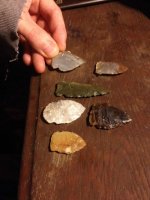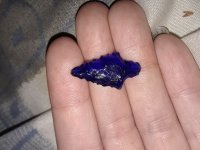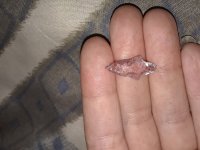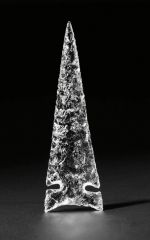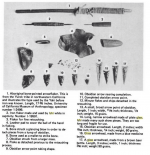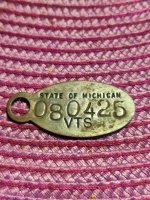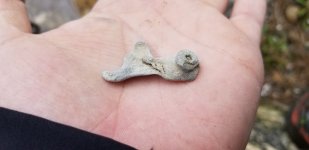You are using an out of date browser. It may not display this or other websites correctly.
You should upgrade or use an alternative browser.
You should upgrade or use an alternative browser.
Flintknapping
- Thread starter Apriltaylor
- Start date
Apriltaylor
Jr. Member
- Thread starter
- #3
Some of it is, not sure bout all of them. Oh, and thank you!
monsterrack
Silver Member
- Apr 15, 2013
- 4,419
- 5,816
- Detector(s) used
- Garrett, and Whites
- Primary Interest:
- All Treasure Hunting
He has the right idea, but he should get a book on how to flint knap or watch on-line video's and it will solve a lot of the problems he is having. Just remind him of one thing to be a flintknapper you got to break a lot of rock and take some cuts along the way. I may have a book around here from when I first learned how, I'll look and if I find them I'll PM you for an address. nativewayonline.com has some real good starter kits that have all you need to start out knapping for around $30.
quito
Silver Member
Looks like he is off to a good start!!
Good kid. Not satisfied and wants to learn more. When he picks up a piece of Indian worked flint in the field, he will know the how and why immediately. Others can only guess. Gary
He did great. I tried it once and it was a total failure.
Apriltaylor
Jr. Member
- Thread starter
- #8
Well, full disclosure, he's 24. Lol
Apriltaylor
Jr. Member
- Thread starter
- #9
If your son is interested in authentic flintknapping methods, there are many avenues left to explore. Most of the flintknapping theories that have been espoused over the last half a century were mainly developed in Europe. Very little attention has been given to the flaking tools, and technologies, used by Native Americans, since probably the 1950's. The baton technique was used by Australian aborigines to chip glass, and was developed by European academics, in the 1930's, as a hypothetical way to explain "secondary flaking". Since then, many academics have pointed out that there is insufficient evidence to suppose that the same technologies were used in the Americas. Prior to that, the predominant belief was that indirect percussion was used for secondary flaking. Only, as Holmes wrote, in 1919, it was not well understood. Today, one can see all of the people on the copper percussion bandwagon, which certainly is a departure from authenticity. So, we still have a long ways to go, in terms of understanding authenticity in the Americas.
Here is a flaking technology that I posted on Facebook that quickly traveled far and wide, even through Europe in practically 24 hours. In Europe, many people have a sincere interest in authentic flaking practices. The type of flaker is very commonly found in archaeological sites, in North America, and Central America. It looks like a very small pressure flaker, just a few inches long. Sometimes, it is blunt. Other times, it will show percussive chips removed from the end, even with bulbar negative flake scars. Some of the American collectors on Facebook saw this video and proclaimed that they believe this is exactly how the tool was used. Another person, I believe in Germany, wrote in German that he saw a very old black and white video of this process being used in the Amazon, by a native person, I believe on archeoforum.
Anyway, I cannot positively say that the tool was used in this manner. But, it does seem to follow Grinnell (1869) who queried an old native person, while living with the Cheyenne, on the plains. The old Cheyenne outlined the entire reductive process, and this process was one step before pressure flaking. The only difference is that a small "stone punch" was described as being held between the fingers, whereas I am using a very common small antler flaking tool that is frequently overlooked.
Anyway, for the size and materials that your son is using, this process might work really well for him.
Here is an example of a cut tine tip flaker, which is a very commonly found flaker that most people overlook.
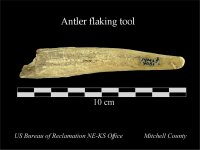
Anyone who can use facsimiles of real tools, and produce results comparable to what is known from the archaeological record, will do a real service to archaeology, and to the world, since so much of our understanding of history is based on "broken rocks", and related technologies.
Here is a flaking technology that I posted on Facebook that quickly traveled far and wide, even through Europe in practically 24 hours. In Europe, many people have a sincere interest in authentic flaking practices. The type of flaker is very commonly found in archaeological sites, in North America, and Central America. It looks like a very small pressure flaker, just a few inches long. Sometimes, it is blunt. Other times, it will show percussive chips removed from the end, even with bulbar negative flake scars. Some of the American collectors on Facebook saw this video and proclaimed that they believe this is exactly how the tool was used. Another person, I believe in Germany, wrote in German that he saw a very old black and white video of this process being used in the Amazon, by a native person, I believe on archeoforum.
Anyway, I cannot positively say that the tool was used in this manner. But, it does seem to follow Grinnell (1869) who queried an old native person, while living with the Cheyenne, on the plains. The old Cheyenne outlined the entire reductive process, and this process was one step before pressure flaking. The only difference is that a small "stone punch" was described as being held between the fingers, whereas I am using a very common small antler flaking tool that is frequently overlooked.
Anyway, for the size and materials that your son is using, this process might work really well for him.
Here is an example of a cut tine tip flaker, which is a very commonly found flaker that most people overlook.

Anyone who can use facsimiles of real tools, and produce results comparable to what is known from the archaeological record, will do a real service to archaeology, and to the world, since so much of our understanding of history is based on "broken rocks", and related technologies.
Last edited:
- Jan 27, 2009
- 18,717
- 11,709
- 🥇 Banner finds
- 1
- Detector(s) used
-
Tesoro Conquistador freq shift
Fisher F75
Garrett AT-Pro
Garet carrot
Neodymium magnets
5' Probe
- Primary Interest:
- All Treasure Hunting
A friend has several complete knapping kits recovered from long ago. They each would include the antler for pressure flaking and often a round piece of a flint spall with the soft cortex on.Included in the kits were preforms and rocks for abrading the edges and hammer stones for the larger reduction. I am sure each kit was different for the area you lived and the available billets from animals.
I do have a flint pressure flakingg core. If not have seen it in the kits I would have left it laying in the dirt.
MonsterRack is an expert in tool making and reproduction work also.
I do have a flint pressure flakingg core. If not have seen it in the kits I would have left it laying in the dirt.
MonsterRack is an expert in tool making and reproduction work also.
A friend has several complete knapping kits recovered from long ago. They each would include the antler for pressure flaking and often a round piece of a flint spall with the soft cortex on.Included in the kits were preforms and rocks for abrading the edges and hammer stones for the larger reduction. I am sure each kit was different for the area you lived and the available billets from animals.
I do have a flint pressure flakingg core. If not have seen it in the kits I would have left it laying in the dirt.
MonsterRack is an expert in tool making and reproduction work also.
That is really interesting. I am not very good at making anything with tools at all. But, I did make this Clovis replica from raw chert, with a process that was recorded during the 19th century, and that has not been seen used in the modern age. It is a process that was recorded by Franklin Cushing, from maybe the 1870's. I even used the process to create the flute. All of the flaking was done with the tip of a common deer tine - no billet needed.
Also, I taught the process to a number of people since December of 2017. One archaeologist learned, and he took the flaking results to compare to collections, both paleo and archaic. And, he told me with great excitement that the types of flakes being produced - even the overshot flakes - are a type known as "split negative cone" flakes, which he said are not known experimentally to modern science, except in one single instance. And, that instance has nothing to do with this technology. Yet, he said that there is widespread evidence of the same thing being present in both archaic, and paleo, assemblages. And, to their amazement, I produced the same results. He said that in collaborating with other archaeologists, no one has ever seen anything like it. There are quite a few archaeologists who are really excited about this development. But, he also told me that there are some people who are really going to hate me. Lol! The truth rolls on! No good deed goes unpunished!
Last edited:
- Jan 27, 2009
- 18,717
- 11,709
- 🥇 Banner finds
- 1
- Detector(s) used
-
Tesoro Conquistador freq shift
Fisher F75
Garrett AT-Pro
Garet carrot
Neodymium magnets
5' Probe
- Primary Interest:
- All Treasure Hunting
That is really interesting. I am not very good at making anything with tools at all. But, I did make this Clovis replica from raw chert, with a process that was recorded during the 19th century, and that has not been seen used in the modern age. It is a process that was recorded by Franklin Cushing, from maybe the 1870's. I even used the process to create the flute. All of the flaking was done with the tip of a common deer tine - no billet needed.
Also, I taught the process to a number of people since December of 2017. One archaeologist learned, and he took the flaking results to compare to collections, both paleo and archaic. And, he told me with great excitement that the types of flakes being produced - even the overshot flakes - are a type known as "split negative cone" flakes, which he said are not known experimentally to modern science, except in one single instance. And, that instance has nothing to do with this technology. Yet, he said that there is widespread evidence of the same thing being present in both archaic, and paleo, assemblages. And, to their amazement, I produced the same results. He said that in collaborating with other archaeologists, no one has ever seen anything like it. There are quite a few archaeologists who are really excited about this development. But, he also told me that there are some people who are really going to hate me. Lol! The truth rolls on! No good deed goes unpunished!
That is really cool. You were able to get overshot with pressure flaking. I imagine a lot depends upon the material?
That is really cool. You were able to get overshot with pressure flaking. I imagine a lot depends upon the material?
Close. In January of 2015, after five years of really intense study I realized how to create overshot by combining pressure and indirect percussion over a fulcrum, inside of leather.
This idea is actually blueprinted in a verbal explanation of native flaking processes, that I found in a lecture that was transcribed in 1879. I realized one morning that the text actually gives the blueprints for a kind of flaking that could be used to create overshot flaking, as well as regular flaking.
Twenty minutes later, I used the directions to produce overshot on raw stone, and then quartz crystal, obsidian, chert, heat treated stone, etc. Here is the flaker, so you can see the pointy tip. And, here are some of the results. I think this was my fourth successful attempt at using the process.
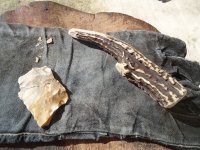
The narrow side of the flake is where it started. The wide side is where it ended, after turning 90 degrees, as planned. It is a true overshot, and controlled as well.
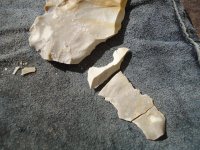
On the left side, you can see the peculiar split cone initiation that seems to have gotten some archaeologists excited. It looks like a narrow gouge in the rock, and leads to overshot, in this case.
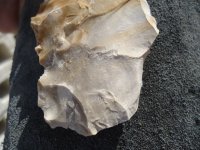
Refitting the pieces.
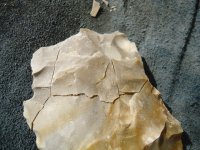
Also, I showed results like this to the flintknapping community for three years, in the places where they will let me post. Over the course of three years, flintknappers came up with all sorts of guesses. But, no one could figure out how it was done. Some thought I used the flaker like a big "can opener". Others thought that I was fibbing about the tool. Others tried all sorts of ways. But, I always told them that they should check the 19th century records very very carefully, and don't assume that a method can only produce one type of flaking. I also told them that they should recheck the information that I had posted between 2010 and 2011, because the answer was always there.
Finally, after three years of testing the flintknappers, I made a video to show the process on Christmas Day, of 2017. Bear in mind that in 2010, most leading flintknappers adhered to the belief that indirect percussion was not used in bifacial reduction, but only in blade core work. I actually proved that sophisticated indirect percussion can work better than direct percussion, for a host of reasons. And, my three years of unexplained demonstrations drove the point home. Lol! By the way, that little flake scar initiation is what I believe archaeologists are calling a "split cone flake scar", or something to that effect. They tell me that this flake scar has never been reproduced experimentally, except by one method. And, that method does not produce overshots like my method, or the method derived from 19th century writings.
Anyway, to answer your question, this stone is horrible. But, I still achieved a full blown overshot, with a right angle turn prior to the break reaching the opposite edge. Also, this is a stone that percussion knappers usually cook for 12 to 15 hours, and comes from central america. It is one of the worst stones to flintknap raw. But, here you can see a full edge to edge overshot made with the tip of a deer tine, in a way that no knapper could decode, decipher, or understand, for three straight years.
Also, the newest people are having the easiest time learning, and the most experienced knappers are having the hardest time learning. Here is an example of the first overshot attempt carried out with this method by a new knapper, I think in California. Some of the newest knappers who hit the biggest overshots said that this is the easiest way to drastically thin a stone, they have ever tried. They said that it was easier than boppers, batons, billets, hammerstones, etc. And, some of these guys had only been knapping for a few months when they produced these results, within just a few attempts.
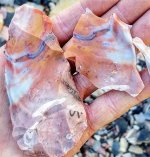
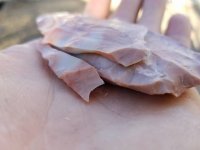
By the way, overshot is fairly easy to achieve with hammerstones. The problem is that it is mostly destructive, when carried out with hammerstones. The tine flaking process can be used to generate the overshots with control, at a much later stage, and for much greater thinning, in the very final stages. And, that will not work with hammerstones, in the final stages.
There is a tremendous need for the study of bonafide flaking tools, and potentially bonafide flaking processes. That is what makes this site so nice. The flaking tools depicted are awesome.
By the way, most knappers would have turned their noses up at a big deer tine flaking tool. No one ever expected that this tool is potentially a massive overshot maker, to the person who knows the secret.
Last edited:
There is more than one way to skin a cat. Indirect percussion is one way. You could probably say that some of them used indirect all of the time, all of them used indirect some of the time, but to say all of them used indirect all of the time is a real stretch. Too many anter billets have been found to discount that method. Gary
The baton technique was used by Australian aborigines to chip glass, and was developed by European academics, in the 1930's, as a hypothetical way to explain "secondary flaking". Since then, many academics have pointed out that there is insufficient evidence to suppose that the same technologies were used in the Americas. Prior to that, the predominant belief was that indirect percussion was used for secondary flaking. Only, as Holmes wrote, in 1919, it was not well understood. Today, one can see all of the people on the copper percussion bandwagon, which certainly is a departure from authenticity. So, we still have a long ways to go, in terms of understanding authenticity in the Americas.
Ishi, the last Yahi, made some glass arrowheads. One for auction at Skinners is here
I forgot his method, I read the book years ago; however, he used traditional methods. The researcher wrote that the Yahi would paint their faces with mud to keep glass & obsidian from getting in the eyes.
His tools are shown here
Attachments
Top Member Reactions
-
 1988
1988 -
 987
987 -
 956
956 -
 934
934 -
 873
873 -
 827
827 -
 769
769 -
 711
711 -
 600
600 -
 525
525 -
 505
505 -
 488
488 -
 466
466 -
 461
461 -
O
430
-
 419
419 -
 375
375 -
 370
370 -
 369
369 -
 368
368
Users who are viewing this thread
Total: 2 (members: 0, guests: 2)
